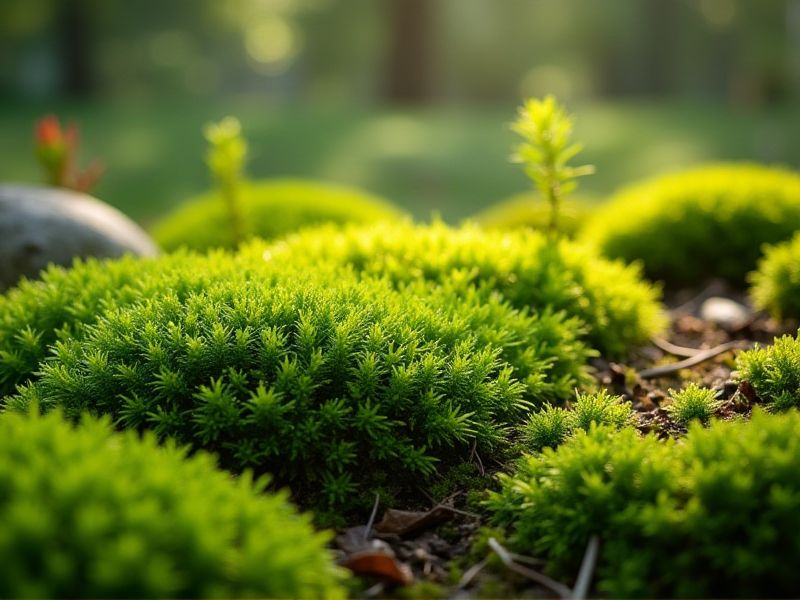
Moss plants thrive in shaded environments, making them ideal for regions with limited sunlight. They typically flourish in moist, cool conditions, often found in forests, alongside streams, or on the north sides of trees and rocks. Species like Sphagnum moss are notable for their ability to retain water, playing a crucial role in soil health and erosion control. Your garden can benefit from incorporating moss, as it creates a lush, green cover while requiring minimal maintenance. They also provide habitat for various small organisms, contributing to biodiversity in shaded ecosystems.
List of some Moss plants that grow in shade
- Common Haircap Moss (Polytrichum commune)
- Cushion Moss (Leucobryum glaucum)
- Feather Moss (Hypnum cupressiforme)
- Plume Moss (Ptilium crista-castrensis)
- Sheet Moss (Hypnum imponens)
- Shiny Seductress Moss (Entodon seductrix)
- Tree Moss (Climacium americanum)
- Fern Moss (Thuidium delicatulum)
- Cord Moss (Funaria hygrometrica)
- Delicate Fern Moss (Thuidium tamariscinum)
Important things about Moss plants that grow in shade
Growth Habitat Requirements
Moss plants thrive in shaded environments, making them ideal for areas where sunlight is limited. These non-vascular plants flourish in moist, cool conditions, often found in forests, wetlands, and alongside shaded rocks or tree trunks. Your garden can benefit from incorporating shady spots that provide a damp microclimate, allowing mosses like species of Sphagnum or Polytrichum to establish and thrive. To support their growth, ensure the soil remains consistently moist but not waterlogged, as excessive dryness can hinder moss development.
Light Sensitivity
Moss plants thrive in shaded environments, often exhibiting adaptations that enable them to maximize light absorption. These plants possess a unique morphology, allowing them to capture diffused sunlight efficiently, which is crucial for photosynthesis in low-light conditions. The chlorophyll concentration in mosses is typically higher, enhancing their ability to utilize the minimal light available in shaded areas. By minimizing water loss and maximizing light capture, mosses play a vital role in forest ecosystems, contributing to soil health and biodiversity.
Moisture Retention
Moss plants thrive in shaded environments, capitalizing on the higher humidity and moisture levels prevalent in these areas. These non-vascular plants possess unique adaptations that allow them to absorb and retain water directly through their leaves and stems, making them efficient moisture retainers. Mosses create a microhabitat that fosters a lush, cool environment, reducing evaporation and preventing desiccation. If you cultivate mosses in shaded locations, you can enjoy their soft green carpets while promoting biodiversity and stabilizing soil moisture.
Soil Types Preference
Moss plants thrive in shaded environments where moisture is abundant, making the soil type essential for their growth. They prefer acidic to neutral soils, typically ranging from pH 5.0 to 7.0, as this supports their delicate structure and nutrient absorption. Organic-rich substrates, such as decomposed leaves and peat, enhance their ability to retain moisture and nutrients, creating an ideal habitat. If you are cultivating moss, ensure your area has well-drained soil that remains consistently damp, promoting lush and healthy growth.
Reproductive Methods
Moss plants, particularly those thriving in shaded environments, predominantly reproduce through asexual methods such as fragmentation and gemmae formation. Fragmentation occurs when broken pieces of moss can establish new plants, while gemmae are specialized reproductive structures that, when dispersed, can grow into new moss colonies. In shaded habitats, where light is limited but moisture is abundant, these reproductive strategies ensure survival and colonization in competitive ecosystems. Understanding these methods can enhance your appreciation of moss diversity and their essential role in forest understories, contributing to biodiversity and soil stability.
Tolerance To Temperature Fluctuations
Moss plants, often found in shaded environments, exhibit remarkable tolerance to temperature fluctuations. These cryptogams thrive in cooler, damp conditions, which helps them maintain moisture and minimize desiccation stress. Their unique physiological adaptations, such as poikilohydry, allow them to efficiently absorb water from humidity in the air, enabling survival during extreme temperature variations. If you're cultivating moss in shaded areas, understanding their temperature tolerance can enhance their growth and resilience in variable climates.
Symbiotic Relationships
Moss plants thrive in shaded areas, forming essential symbiotic relationships that enhance their survival and growth. These mosses often partner with fungi in a mycorrhizal association, allowing for improved nutrient uptake, particularly phosphorus, from the surrounding environment. The moisture-retaining properties of moss create a microhabitat that benefits various microorganisms, which contribute to soil health and nutrient cycling. By fostering these relationships, you can cultivate a vibrant ecosystem in shaded gardens or wooded areas that supports biodiversity and enhances the beauty of natural landscapes.
Nutrient Absorption Capabilities
Moss plants thrive in shaded environments and possess unique adaptations for nutrient absorption. These non-vascular plants have a large surface area relative to their volume, allowing them to efficiently capture moisture and dissolved nutrients from their surroundings. In low-light conditions, mosses utilize symbiotic relationships with microorganisms in the soil to enhance nutrient uptake, particularly nitrogen and phosphorus. To optimize growth, you can improve the soil conditions by ensuring adequate moisture retention and minimizing competition from larger plants in the vicinity.
Impact On Local Ecosystems
Moss plants, thriving in shaded environments, play a crucial role in local ecosystems by retaining moisture and enhancing soil quality. Their ability to absorb water and nutrients contributes to the health of surrounding flora, supporting a diverse range of plant species. Moss serves as a habitat for various microorganisms, offering a unique micro-ecosystem that can influence the biodiversity of shaded woodlands. By understanding the importance of moss in these environments, you can appreciate its vital function in maintaining ecological balance and promoting sustainable growth.
Common Species Examples
Moss species thrive in shaded environments, often creating lush green carpets in damp, low-light conditions. Notable species include *Polytrichum commune*, which forms dense tufts and can tolerate semi-dry conditions, and *Dicranum scoparium*, recognized for its striking upright growth pattern. You may also encounter *Hypnum moss*, favored for its spreading habit over soil and rocks, contributing to soil erosion control. These shade-loving mosses play a crucial role in maintaining ecosystem health by retaining moisture and providing habitat for microfauna.
